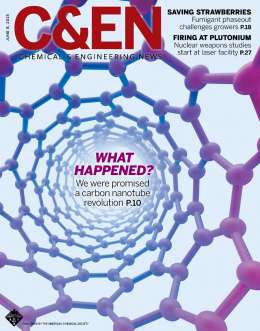
JUNE 8, 2015 ISSUE, VOL. 93 | ISS. 23 Twists And Shouts: A Nanotube Story Nanotechnology’s chiral superstars were overshadowed by hype, but researchers believe they still have potential
The June 8 issue of the American Chemical Society‘s C&EN magazine quotes Boris Yakobson in its Cover Story “Twists And Shouts: A Nanotube Story“.
The timeline of major events in the history of carbon nanotubes features the Artyukhov–Penev–Yakobson (APY) theory of nanotube chirality in the most recent “Nanotubes Today” chapter. The APY theory combines the nanotube/catalyst interface thermodynamics with the kinetic growth theory to show that the unusual near-armchair peaks, repeatedly revealed in catalytic growth experiments over the last decade, emerge from the two antagonistic trends at the interface: energetic preference towards achiral versus the faster growth kinetics of chiral nanotubes. This narrow distribution is inherently related to the peaked behaviour of a simple function, xe−x.


